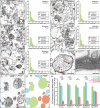Proteomic comparison of different synaptosome preparation procedures
- PMID: 33211194
- PMCID: PMC7695668
- DOI: 10.1007/s00726-020-02912-6
Proteomic comparison of different synaptosome preparation procedures
Abstract
Synaptosomes are frequently used research objects in neurobiology studies focusing on synaptic transmission as they mimic several aspects of the physiological synaptic functions. They contain the whole apparatus for neurotransmission, the presynaptic nerve ending with synaptic vesicles, synaptic mitochondria and often a segment of the postsynaptic membrane along with the postsynaptic density is attached to its outer surface. As being artificial functional organelles, synaptosomes are viable for several hours, retain their activity, membrane potential, and capable to store, release, and reuptake neurotransmitters. Synaptosomes are ideal subjects for proteomic analysis. The recently available separation and protein detection techniques can cope with the reduced complexity of the organelle and enable the simultaneous qualitative and quantitative analysis of thousands of proteins shaping the structural and functional characteristics of the synapse. Synaptosomes are formed during the homogenization of nervous tissue in the isoosmotic milieu and can be isolated from the homogenate by various approaches. Each enrichment method has its own benefits and drawbacks and there is not a single method that is optimal for all research purposes. For a proper proteomic experiment, it is desirable to preserve the native synaptic structure during the isolation procedure and keep the degree of contamination from other organelles or cell types as low as possible. In this article, we examined five synaptosome isolation methods from a proteomic point of view by the means of electron microscopy, Western blot, and liquid chromatography-mass spectrometry to compare their efficiency in the isolation of synaptosomes and depletion of contaminating subcellular structures. In our study, the different isolation procedures led to a largely overlapping pool of proteins with a fairly similar distribution of presynaptic, active zone, synaptic vesicle, and postsynaptic proteins; however, discrete differences were noticeable in individual postsynaptic proteins and in the number of identified transmembrane proteins. Much pronounced variance was observed in the degree of contamination with mitochondrial and glial structures. Therefore, we suggest that in selecting the appropriate isolation method for any neuroproteomics experiment carried out on synaptosomes, the degree and sort/source of contamination should be considered as a primary aspect.
Keywords: Neuroproteomics; Proteomics; Subcellular proteomics; Synapse; Synaptosome.
Conflict of interest statement
The authors declare that they have no conflict of interest.
Figures



Similar articles
-
Isolation of Synaptosomes, Synaptic Plasma Membranes, and Synaptic Junctional Complexes.Methods Mol Biol. 2017;1538:107-119. doi: 10.1007/978-1-4939-6688-2_9. Methods Mol Biol. 2017. PMID: 27943187
-
Proteomic analysis of synaptosomes using isotope-coded affinity tags and mass spectrometry.Proteomics. 2005 Jul;5(10):2531-41. doi: 10.1002/pmic.200401198. Proteomics. 2005. PMID: 15984043
-
Purification of Synaptosome Populations Using Fluorescence-Activated Synaptosome Sorting.Methods Mol Biol. 2017;1538:121-134. doi: 10.1007/978-1-4939-6688-2_10. Methods Mol Biol. 2017. PMID: 27943188
-
Synaptosome proteomics.Subcell Biochem. 2007;43:77-98. doi: 10.1007/978-1-4020-5943-8_6. Subcell Biochem. 2007. PMID: 17953392 Free PMC article. Review.
-
Proteomic analysis of the presynaptic active zone.Exp Brain Res. 2012 Apr;217(3-4):449-61. doi: 10.1007/s00221-012-3031-x. Epub 2012 Feb 22. Exp Brain Res. 2012. PMID: 22354101 Review.
Cited by
-
Microtransplantation of Postmortem Native Synaptic mGluRs Receptors into Xenopus Oocytes for Their Functional Analysis.Membranes (Basel). 2022 Sep 26;12(10):931. doi: 10.3390/membranes12100931. Membranes (Basel). 2022. PMID: 36295690 Free PMC article.
-
Alterations in the Proteome of Developing Neocortical Synaptosomes in the Absence of MET Signaling Revealed by Comparative Proteomics.Dev Neurosci. 2023;45(3):126-138. doi: 10.1159/000529981. Epub 2023 Mar 7. Dev Neurosci. 2023. PMID: 36882009 Free PMC article.
-
Gene Expression at the Tripartite Synapse: Bridging the Gap Between Neurons and Astrocytes.Adv Neurobiol. 2024;39:95-136. doi: 10.1007/978-3-031-64839-7_5. Adv Neurobiol. 2024. PMID: 39190073 Free PMC article. Review.
-
Protocol to assess engulfment and degradation of synaptosomes by murine microglia in vitro.STAR Protoc. 2025 Jul 10;6(3):103936. doi: 10.1016/j.xpro.2025.103936. Online ahead of print. STAR Protoc. 2025. PMID: 40650902 Free PMC article.
-
Bringing synapses into focus: Recent advances in synaptic imaging and mass-spectrometry for studying synaptopathy.Front Synaptic Neurosci. 2023 Mar 15;15:1130198. doi: 10.3389/fnsyn.2023.1130198. eCollection 2023. Front Synaptic Neurosci. 2023. PMID: 37008679 Free PMC article. Review.
References
MeSH terms
Substances
Grants and funding
- FIEK 16-1-2016-0005/Nemzeti Kutatási Fejlesztési és Innovációs Hivatal
- KTIA_NAP_13-1-2013-0001/Nemzeti Kutatási Fejlesztési és Innovációs Hivatal
- KTIA_NAP_B_13-2-2014-0004/Nemzeti Kutatási Fejlesztési és Innovációs Hivatal
- KTIA_NAP_13-2-2015-0003/Nemzeti Kutatási Fejlesztési és Innovációs Hivatal
- KMOP-1.1.5-08-2009-0001/Richter Gedeon Talentum Alapítvány
LinkOut - more resources
Full Text Sources
Research Materials

